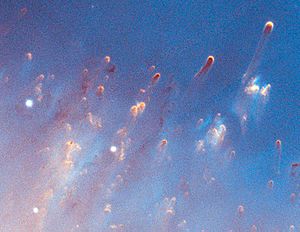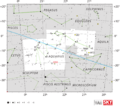Helix Nebula facts for kids
The Helix Nebula is a beautiful cloud of gas and dust in space. It's called a planetary nebula because it looks a bit like a planet through older telescopes, but it's actually the remains of a dying star. You can find it in the constellation of Aquarius. This amazing nebula is about 700 light-years away from our Earth. That's a very long distance!

Shape and Size of the Helix Nebula
Scientists believe the Helix Nebula looks like a stretched-out ball, similar to a rugby ball or an American football. This shape is called a prolate spheroid. From Earth, we see it tilted at an angle, which makes it look a bit different.
The nebula has several parts, like rings or disks. The inner disk is about 0.52 parsecs wide. A parsec is a huge unit of distance, much bigger than a light-year! The next part, an outer ring, is about 0.77 parsecs wide. The very outermost ring is even bigger, about 1.76 parsecs across.
This outermost ring looks a bit flattened on one side. This is because it is bumping into the gas and dust that fills the space between stars, called the interstellar medium.
Scientists have also figured out how fast the nebula is growing. The entire nebula has been expanding for about 6,560 years. The inner disk has been expanding for even longer, about 12,100 years. The outer ring is expanding at a speed of 40 kilometers per second, while the inner disk expands at about 32 kilometers per second. That's super fast!
What Are Cometary Knots?
The Helix Nebula was the first planetary nebula where strange features called "cometary knots" were found. These knots are small, dense clumps of gas and dust. They are now seen in many other planetary nebulae too.
These knots look a bit like tiny comets. Each knot has a bright, pointed head that faces the central star of the nebula. This head is where the gas is being lit up by the star's energy. Behind the head, there's a long tail that stretches away from the central star.
Each of these knots is roughly the size of our entire Solar System! They are very dense and block a lot of light from the central star. Scientists believe there are more than 20,000 of these cometary knots in the Helix Nebula.
The temperature inside the Helix Nebula changes. In the inner parts, near the central star, the temperature inside a cometary knot can be around 1800 K. As you move further out to the edge of the nebula, the temperature drops to about 900 K.
Images for kids
See also
 In Spanish: Nebulosa de la Hélice para niños
In Spanish: Nebulosa de la Hélice para niños





